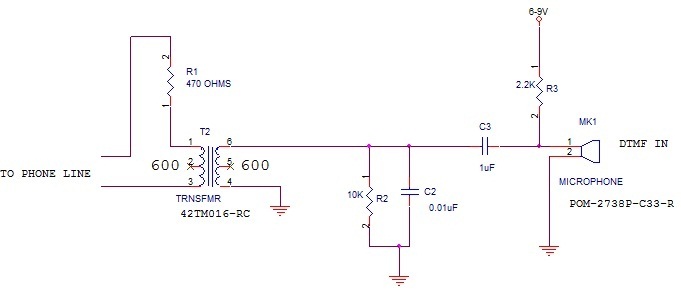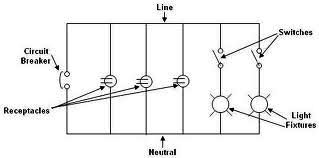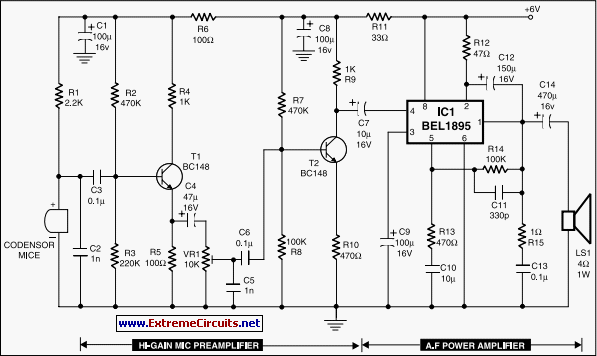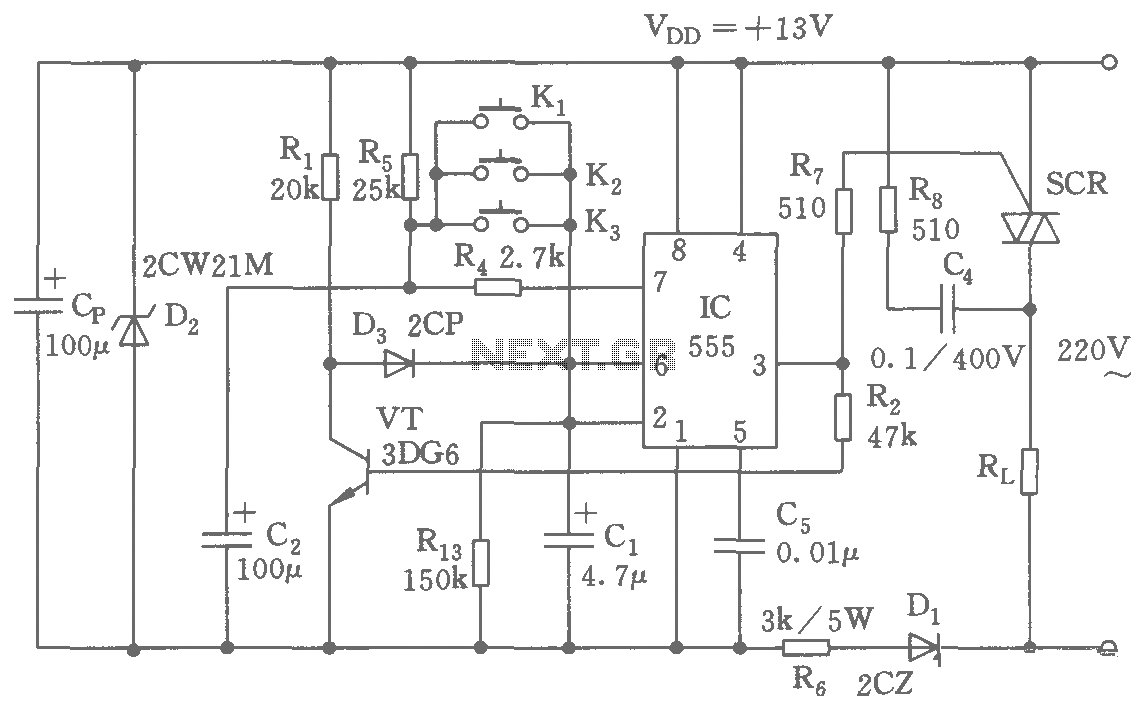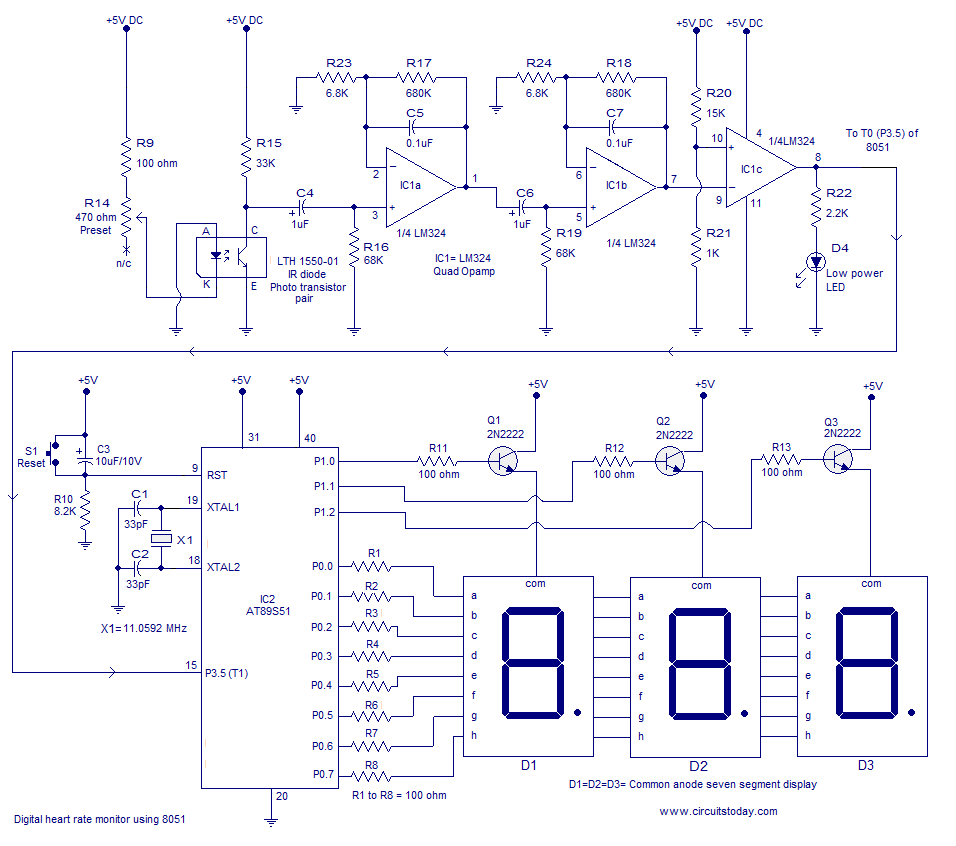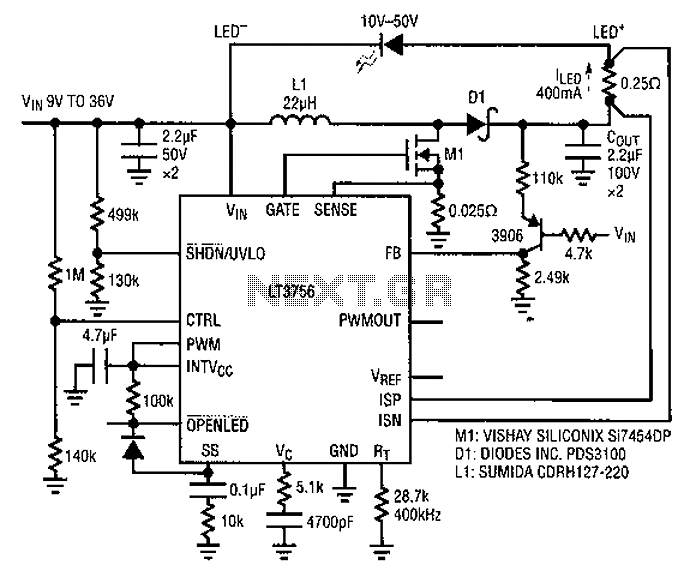
mic 702 mictronics schematic diagram
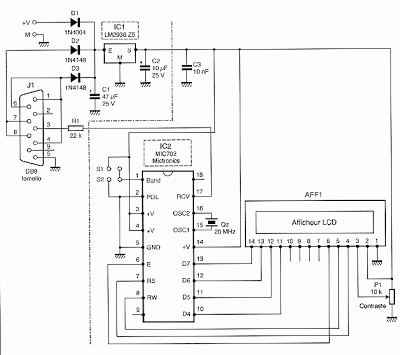
To convert a standard LCD interface from parallel to a serial interface model, a microcontroller or a dedicated circuit such as the MIC 702 from Mictronics can be used. This circuit is specifically designed to transform the parallel interface and LCD display logic into an integrated asynchronous serial interface. Its implementation is straightforward, as illustrated in the accompanying diagram. The MIC 702 connects directly to the display, ensuring perfect compatibility. It is noteworthy that only 4 high-weight data bits are required, as the MIC 702 operates in a display mode utilizing 4 bits. On the PC side, the connection to the serial output does not require a level converter for RS-232 to TTL conversion; this function is fulfilled by a single resistor, R1, rated at 22 ohms, which is essential for operation. The BAUD tab allows selection of the circuit's operating speed between two options: 9600 bps with switch S1 or 2400 bps with switch S2. The POL pin enables the circuit to interpret the serial data as either direct or inverted. In a direct RS-232 link, this pin should be connected to ground to indicate to the MIC 702 that it is receiving inverted data. If connected to +5 volts, it would receive direct data, as would be the case when using this circuit with a Basic Stamp, for example. For non-backlit displays, the total power consumption is low enough to draw power directly from the control signals of the RS-232. This is facilitated by diodes D2 and D3, which work in conjunction with IC1, a low-dropout voltage regulator with low consumption. However, if a backlit display is used, the power consumption of the backlight may exceed the capacity of the PC's serial port. In such cases, an external power supply can be utilized via diode D1, with a recommended voltage of 9 volts and a current capacity of 100 mA.
The MIC 702 circuit provides a robust solution for interfacing standard LCD displays with serial communication systems. The design allows for seamless conversion from parallel to serial, which is particularly advantageous in applications where space and wiring complexity must be minimized. The choice of a low-dropout regulator ensures that the circuit maintains efficient power management, which is critical in battery-operated devices. The use of a simple resistor for level shifting simplifies the design, reducing the need for additional components, which can lead to increased reliability and reduced manufacturing costs.
In terms of implementation, the circuit should be laid out carefully to minimize noise and interference, particularly in the data lines. Proper decoupling capacitors should be placed near the power pins of the MIC 702 to ensure stable operation. Additionally, it is advisable to use twisted pair wiring for the serial connection to further reduce electromagnetic interference, especially in environments with high-frequency noise. The selection of the appropriate baud rate is crucial for ensuring reliable data transmission, and careful consideration should be given to the specific requirements of the application when configuring the POL pin to match the data format being used.
Overall, the MIC 702 circuit represents an efficient and effective means of interfacing parallel LCD displays with serial communication systems, enhancing the versatility of display solutions in a variety of electronic applications.To convert a standard LCD interface parallel to serial interface model, use a microcontroller or a dedicated circuit such as the MIC 702 Mictronics you can download the complete data sheet and French by clicking this link. This is a circuit specially designed to transform the parallel interface and LCD display logic integrated asynchronous serial
interface standard. Its implementation is very simple as shown in the diagram below. The MIC 702 is connected directly to the display with which it is perfectly compatible. Notice the connection with only 4 data bits of high weight since the MIC 702 operates in the display mode twice 4 bits. PC side, the connection with the serial output of the PC does not involve any level converter for RS 232 TTL, this role being played by the only resistor R1 22 ohm whose presence is essential.
BAUD The tab allows you to choose the operating speed of the circuit between two speeds: 9600 bps up with S1 or S2 with 2400 baud up. The leg POL allows the circuit to interpret the serial data as direct or inverted. As it is in direct RS232 link should be link this foot to ground to indicate the MIC 702 that receives data reversed.
Linkage to +5 volts it would receive direct evidence as would be the case if we wanted to use this circuit with a Basic Stamp example. Subject to use a display not backlit, the total consumption of the circuit is low enough that it can take its power directly from the output control signals to the RS 232.
It is the role of diodes D2 and D3 associated with IC1, which is a regulator with low dropout voltage and low consumption. If you insist on using a backlit display, it is possible that consumption of its single backlight exceeds the possibilities of the PC`s serial port.
You can use an external power supply via the diode D1. A voltage of 9 volts at a flow rate of a hundred mA appropriate. 🔗 External reference
The MIC 702 circuit provides a robust solution for interfacing standard LCD displays with serial communication systems. The design allows for seamless conversion from parallel to serial, which is particularly advantageous in applications where space and wiring complexity must be minimized. The choice of a low-dropout regulator ensures that the circuit maintains efficient power management, which is critical in battery-operated devices. The use of a simple resistor for level shifting simplifies the design, reducing the need for additional components, which can lead to increased reliability and reduced manufacturing costs.
In terms of implementation, the circuit should be laid out carefully to minimize noise and interference, particularly in the data lines. Proper decoupling capacitors should be placed near the power pins of the MIC 702 to ensure stable operation. Additionally, it is advisable to use twisted pair wiring for the serial connection to further reduce electromagnetic interference, especially in environments with high-frequency noise. The selection of the appropriate baud rate is crucial for ensuring reliable data transmission, and careful consideration should be given to the specific requirements of the application when configuring the POL pin to match the data format being used.
Overall, the MIC 702 circuit represents an efficient and effective means of interfacing parallel LCD displays with serial communication systems, enhancing the versatility of display solutions in a variety of electronic applications.To convert a standard LCD interface parallel to serial interface model, use a microcontroller or a dedicated circuit such as the MIC 702 Mictronics you can download the complete data sheet and French by clicking this link. This is a circuit specially designed to transform the parallel interface and LCD display logic integrated asynchronous serial
interface standard. Its implementation is very simple as shown in the diagram below. The MIC 702 is connected directly to the display with which it is perfectly compatible. Notice the connection with only 4 data bits of high weight since the MIC 702 operates in the display mode twice 4 bits. PC side, the connection with the serial output of the PC does not involve any level converter for RS 232 TTL, this role being played by the only resistor R1 22 ohm whose presence is essential.
BAUD The tab allows you to choose the operating speed of the circuit between two speeds: 9600 bps up with S1 or S2 with 2400 baud up. The leg POL allows the circuit to interpret the serial data as direct or inverted. As it is in direct RS232 link should be link this foot to ground to indicate the MIC 702 that receives data reversed.
Linkage to +5 volts it would receive direct evidence as would be the case if we wanted to use this circuit with a Basic Stamp example. Subject to use a display not backlit, the total consumption of the circuit is low enough that it can take its power directly from the output control signals to the RS 232.
It is the role of diodes D2 and D3 associated with IC1, which is a regulator with low dropout voltage and low consumption. If you insist on using a backlit display, it is possible that consumption of its single backlight exceeds the possibilities of the PC`s serial port.
You can use an external power supply via the diode D1. A voltage of 9 volts at a flow rate of a hundred mA appropriate. 🔗 External reference
Warning: include(partials/cookie-banner.php): Failed to open stream: Permission denied in /var/www/html/nextgr/view-circuit.php on line 713
Warning: include(): Failed opening 'partials/cookie-banner.php' for inclusion (include_path='.:/usr/share/php') in /var/www/html/nextgr/view-circuit.php on line 713
